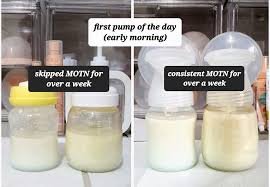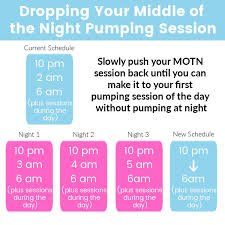Why the MOTN Pumping Session Matters

The MOTN pumping session is not just about milk removal. It’s about supply regulation and preventing discomfort. During the early weeks postpartum, your body produces milk around the clock, and your supply is still being established. Nighttime removal ensures your breasts don’t stay full for long periods, which can prevent engorgement, clogged ducts, and infections.
Babies often wake naturally at night, so for breastfeeding moms, milk removal happens during feeds. For pumping moms, replicating this rhythm is key. That’s why MOTN pumping is highly recommended in the first 12 weeks.
Understanding Prolactin and Night Milk Production

Prolactin is the hormone responsible for milk production, and its levels are highest at night and early morning. This means pumping during the night often yields higher volumes. Many moms notice their MOTN session produces the most milk of the entire day.
Skipping this session early on can send signals to your body that less milk is needed, leading to long-term supply issues. That’s why professionals encourage MOTN sessions, especially in the newborn phase.
The Role of MOTN Pumping in Early Supply Building
Your supply is generally established in the first 12 weeks postpartum. MOTN pumping ensures you’re stimulating your breasts enough times per day to build a solid foundation. Moms who pump consistently during this period usually see stronger supply later on.
Think of MOTN pumping as an investment in your long-term feeding journey. It’s tough, but it pays off.
Common Struggles with MOTN Pumping

While MOTN pumping is helpful, it’s not easy. Common struggles include:
- Extreme fatigue and sleep disruption.
- Difficulty getting back to sleep after pumping.
- Feeling isolated or frustrated.
- Increased stress or anxiety about supply.
Acknowledging these struggles is important—many moms feel guilty, but it’s normal to find this phase hard.
When Is It Safe to Drop the MOTN Pump

There is no single answer, but general timelines are:
- 0–12 weeks: Do not drop. Supply is being established.
- 3–4 months: Some may experiment with dropping, but only if supply is stable.
- 5–6 months: Many moms can safely drop MOTN if daytime pumping is strong.
- Exclusive pumpers: Often need to keep it longer than combo feeders.
Signs You’re Ready to Drop the MOTN Pump

- Your daily output consistently meets baby’s needs.
- Breasts don’t become painfully engorged if you go longer stretches.
- Your baby sleeps longer at night.
- You’ve had no recent issues with clogged ducts.
Risks of Dropping Too Early
- Supply dips that don’t rebound.
- Painful engorgement leading to mastitis.
- Extra stress and worry about milk output.
Dropping too soon can create long-term issues, so caution is key.
Exclusive Pumping vs Combo Feeding Considerations
Exclusive pumpers rely 100% on their pumps for milk removal, so MOTN sessions may need to last longer. Combo feeders, who also breastfeed, may be able to drop MOTN earlier because their baby is still feeding directly at night.
Step by Step Guide to Gradually Dropping MOTN Pump
- Slowly push the session later by 30 minutes every few nights.
- Merge the MOTN pump with your morning pump.
- Add 5–10 minutes to daytime pumps.
- Track supply daily.
- Adjust if dips occur.
Extending Pumping Gaps Safely
Your goal is to avoid sudden long stretches. For example, if you usually pump at 2 a.m. and 6 a.m., stretch to 3 a.m. and 6:30 a.m. instead of skipping completely.
How to Replace MOTN Output During the Day

- Pump longer in the morning when supply is naturally high.
- Add a short afternoon session if needed.
- Power pump to make up for missed ounces.
Sample Pumping Schedules Before Dropping MOTN
Example for a 3-month-old:
- 6 a.m.
- 10 a.m.
- 2 p.m.
- 6 p.m.
- 10 p.m.
- 2 a.m.
Sample Pumping Schedules After Dropping MOTN
Example for a 5-month-old:
- 6 a.m.
- 10 a.m.
- 2 p.m.
- 6 p.m.
- 11 p.m.
Power Pumping as a Safety Net
Power pumping is a technique where you mimic cluster feeding by pumping in short bursts. Doing this once a day can help boost supply if you see a dip after dropping MOTN.
Managing Engorgement During Transition
When extending night gaps, you may feel full. Strategies include:
- Hand expressing a little milk for comfort.
- Cold compresses to reduce swelling.
- Gradual timing changes instead of sudden skips.
Avoiding Clogged Ducts and Mastitis
Always empty your breasts fully during the day. Massage and warm compresses before pumping can help. If you notice lumps, address them immediately.
Tracking Milk Supply After Changes

Keep a log of daily output for at least 2 weeks after dropping MOTN. If you see more than a 10% dip that doesn’t recover, consider adding back a session temporarily.
Nutrition and Hydration to Support Supply
Your body needs fuel to produce milk. Drink plenty of water, eat balanced meals, and don’t skip calories. Foods like oats, nuts, and leafy greens can support supply.
Sleep Benefits of Dropping MOTN Pump
The biggest reward of dropping MOTN is better sleep. Parents often feel more rested, energetic, and emotionally stable when they finally sleep through the night.
Emotional Relief and Mental Health Benefits
Dropping MOTN can reduce stress and anxiety. It gives moms confidence in their supply and more freedom to enjoy time with their baby.
Will My Supply Drop Forever
Not necessarily. Some dips are temporary and recover with adjustments.
What If My Baby Still Wakes at Night?
If your baby feeds at night, you can nurse instead of pumping, or reintroduce a quick pump if needed.
Can I Drop MOTN at 8 Weeks?
It’s not recommended. Supply is still being established. Most lactation experts suggest waiting until at least 12 weeks.
Special Considerations for Preemie Moms
Preemies often need extra milk, so pumping frequently—including MOTN—is important for longer.
MOTN Pumping While Returning to Work
Working moms often consider dropping MOTN to get more rest. If daytime pumping at work is consistent, it’s often possible around 4–6 months.
Balancing Pumping with Partner Support
Partners can help by washing pump parts, preparing bottles, or soothing the baby during MOTN sessions. Dropping MOTN can improve family balance.
Travel Vacations and MOTN Pumping
Travel makes MOTN harder. A gradual drop before a trip may make it easier, but always watch supply.
MOTN Pumping for Moms with Oversupply
Moms with oversupply may drop MOTN earlier, but should watch for painful engorgement.
MOTN Pumping for Moms with Low Supply
Moms struggling with supply may need MOTN longer to avoid dips.
How Long to Wait Before Reintroducing MOTN Pump

If supply drops too much, add MOTN back for 1–2 weeks until stable again.
Testimonials Moms Who Successfully Dropped MOTN
Many moms report finally feeling human again after dropping MOTN. They enjoy more energy and still maintain supply.
Real Stories Moms Who Dropped Too Early
Some moms regret dropping too soon, as their supply dipped permanently. Their advice is: “Don’t rush it.”
Baby Sleep and MOTN Pumping Connection
As babies sleep longer stretches, it becomes easier for moms to stretch pumping intervals. Baby’s sleep often guides the timeline.
Monitoring Wet Diapers and Baby Intake
Make sure your baby is still getting enough milk overall. Wet and dirty diaper counts are the best indicator.
Pumping Gear That Makes MOTN Easier
Hands-free pumps, night lights, and prepped pump parts can make MOTN less stressful until you’re ready to drop it.
Hands Free Pumps and Night Sessions
Portable, wearable pumps make MOTN possible without fully waking up, which helps until you’re ready to stop.
Comfort Hacks for MOTN Pumping
- Keep pump parts in the fridge between sessions.
- Use a pumping bra to stay hands-free.
- Prep everything before bed.
Preparing Mentally to Let Go of MOTN Pump
Many moms feel nervous about stopping. It’s important to trust your body and watch your output.
Long Term Outlook After Dropping MOTN Pump

Once supply is stable without MOTN, most moms never go back. It becomes easier to manage pumping long-term.
Final Tips for Success
- Drop slowly, not suddenly.
- Track your output.
- Replace lost ounces during the day.
- Listen to your body.
Table of Contents
Conclusion
Why the MOTN Pumping Session Matters
Understanding Prolactin and Night Milk Production
The Role of MOTN Pumping in Early Supply Building
Common Struggles with MOTN Pumping
When Is It Safe to Drop the MOTN Pump?
Signs You’re Ready to Drop the MOTN Pump
Risks of Dropping Too Early
Exclusive Pumping vs. Combo Feeding Considerations
Step-by-Step Guide to Gradually Dropping MOTN Pump
Extending Pumping Gaps Safely
How to Replace MOTN Output During the Day
Sample Pumping Schedules Before Dropping MOTN
Sample Pumping Schedules After Dropping MOTN
Power Pumping as a Safety Net
Managing Engorgement During Transition
Avoiding Clogged Ducts and Mastitis
Tracking Milk Supply After Changes
Nutrition and Hydration to Support Supply
Sleep Benefits of Dropping MOTN Pump
Emotional Relief and Mental Health Benefits
FAQs: Will My Supply Drop Forever?
FAQs: What If My Baby Still Wakes at Night?
FAQs: Can I Drop MOTN at 8 Weeks?
Special Considerations for Preemie Moms
MOTN Pumping While Returning to Work
Balancing Pumping with Partner Support
Travel, Vacations, and MOTN Pumping
MOTN Pumping for Moms with Oversupply
MOTN Pumping for Moms with Low Supply
How Long to Wait Before Reintroducing MOTN Pump
Testimonials: Moms Who Successfully Dropped MOTN
Real Stories: Moms Who Dropped Too Early
Baby Sleep and MOTN Pumping Connection
Monitoring Wet Diapers and Baby Intake
Pumping Gear That Makes MOTN Easier
Hands-Free Pumps and Night Sessions
Comfort Hacks for MOTN Pumping
Preparing Mentally to Let Go of MOTN Pump
Long-Term Outlook After Dropping MOTN Pump
Final Tips for Success
Conclusion
Yes, you can drop the MOTN pumping session—but timing is everything. Most moms can safely stop around 4–6 months, with exclusive pumpers sometimes waiting longer. The key is to do it gradually, replace output during the day, and monitor your supply closely. When done right, dropping the MOTN pump means more sleep, more energy, and still enough milk for your baby.

